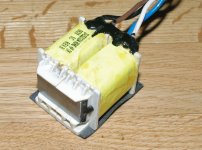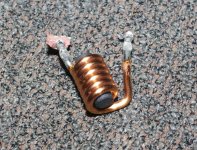I'm saving some parts out of old power supplies..
I noticed some atx supplies have what I thought was a transformer mounted to the side of the case. In a couple of cases it was a 12v tx, but on some others they are labeled as chokes. I looked it up, and they are "pfc chokes". I measure 1.2ohms on one pair of wires, and .47 on the other pair. The schematic shows it wired in similar to a common mode choke, before the rectifiers.
Basically, is it of any use? Could I use 1/2 of it like a normal choke?
And while I'm writing, are the little ferrite rod coils like in the 2nd pic any use for audio circuits/power supplies?
I noticed some atx supplies have what I thought was a transformer mounted to the side of the case. In a couple of cases it was a 12v tx, but on some others they are labeled as chokes. I looked it up, and they are "pfc chokes". I measure 1.2ohms on one pair of wires, and .47 on the other pair. The schematic shows it wired in similar to a common mode choke, before the rectifiers.
Basically, is it of any use? Could I use 1/2 of it like a normal choke?
And while I'm writing, are the little ferrite rod coils like in the 2nd pic any use for audio circuits/power supplies?
Attachments
PFC means Power Factor Correction. Unlikely to be common-mode, as that won't help improve power factor.
But, can I use 1/2 of it as a normal, differential mode choke? It's got a lot of iron in it.
And for the little ferrite rod and toroid inductors , I found specs on most of the parts in these psu's.. Some are around 25uH and 5 amps... Maybe good for filament supplies. The one in the photo is only about .5uH.
And for the little ferrite rod and toroid inductors , I found specs on most of the parts in these psu's.. Some are around 25uH and 5 amps... Maybe good for filament supplies. The one in the photo is only about .5uH.
You can use a choke however you wish. Whether it will do anything useful depends on the choke and the circuit you place it in. It is like asking "Can I use this piece of string?"; the answer must be "Yes, if it is long enough and strong enough for whatever you intend to use it for.".
I've already asked more than that.. I've asked "can I use this piece of string to fly a kite" and supplied a photo of the string... But I suppose you don't know how big the kite is..
So... could a choke such as a PFC choke salvaged from a 500 watt atx power supply, such as pictured above, be used for an average sized PSU filter choke, in the circuits people typically build around here? Say 350v 100ma +/- 20%. (But I don't even care to that level of precision.. just in general could a pfc choke be used as a differential clc type choke?)
I don't know what makes a PFC choke different from other chokes.
So... could a choke such as a PFC choke salvaged from a 500 watt atx power supply, such as pictured above, be used for an average sized PSU filter choke, in the circuits people typically build around here? Say 350v 100ma +/- 20%. (But I don't even care to that level of precision.. just in general could a pfc choke be used as a differential clc type choke?)
I don't know what makes a PFC choke different from other chokes.
You need to measure its inductance. Without that nobody can answer, unless they happen to have measured or used an identical choke. My guess is that its inductance will be far too low for a valve high voltage supply.
Look at it this way: 500W at 125V is 4A, so characteristic impedance is about 31 ohms. 350V at 100mA is 3500 ohms, so you are likely to be about two orders of magnitude off.
Look at it this way: 500W at 125V is 4A, so characteristic impedance is about 31 ohms. 350V at 100mA is 3500 ohms, so you are likely to be about two orders of magnitude off.
OK, thank you. That makes sense. I am downloading some software now that might let me measure the inductance. I need to learn more about chokes/transformers, etc.
The small inductor is easy to deal with: it is a high current , 1 or 2µH choke.I've already asked more than that.. I've asked "can I use this piece of string to fly a kite" and supplied a photo of the string... But I suppose you don't know how big the kite is..
So... could a choke such as a PFC choke salvaged from a 500 watt atx power supply, such as pictured above, be used for an average sized PSU filter choke, in the circuits people typically build around here? Say 350v 100ma +/- 20%. (But I don't even care to that level of precision.. just in general could a pfc choke be used as a differential clc type choke?)
I don't know what makes a PFC choke different from other chokes.
Could be used as a cathode stopper should the need arise, but other than no interest for tube circuits.
The one on the left is more intriguing: normally, PFC inductors are two terminal devices. They can occasionally carry an auxiliary winding, but in that case it is widely different.
In addition, these inductors are normally PCB mounted, because their connections radiate strong E and H field, and are heavy potential disturbers.
The type of core doesn't make sense either: they are mainly toroids of metallic powders like Kool mu, with an occasional gapped ferrite.
This thing looks more like an unusual CM choke, in which case its use is rather limited outside its normal role.
A measurement would be useful: if it is > than a few mH, it is a CM choke
So... could a choke such as a PFC choke salvaged from a 500 watt atx power supply, such as pictured above, be used for an average sized PSU filter choke, in the circuits people typically build around here?
In general - No.
If incorporated into the circuit in the right way it might be possible to use it to help block high frequency interference. But it would be of far too low a value to be effective as a regular smoothing choke in a conventional CLC filtered valve amplifier power supply.
I'm saving some parts out of old power supplies..
I noticed some atx supplies have what I thought was a transformer mounted to the side of the case. In a couple of cases it was a 12v tx, but on some others they are labeled as chokes. I looked it up, and they are "pfc chokes". I measure 1.2ohms on one pair of wires, and .47 on the other pair. The schematic shows it wired in similar to a common mode choke, before the rectifiers.
Basically, is it of any use? Could I use 1/2 of it like a normal choke?
And while I'm writing, are the little ferrite rod coils like in the 2nd pic any use for audio circuits/power supplies?
from an atx psu....the choke is gapped but used in the ac side....
you can series connect them but get the phasing right to make it useful...
All these hobbyists..and nobody wants to make some "scientific" measurements. I just recycled a load of power supplies and some had PFC chokes.
Test results:
input: 10 Vac
rectifier bridge, 4400 microfarad , load 16 ohm
output 10,8 , ripple 0.23 Vac
2200 microf, Pfc choke, 2200 microf.
output10,4 V. ripple 0.022 Vac
Clearly useful for low voltage, medium current applications. Dc supply for preamp tubes.
Test results:
input: 10 Vac
rectifier bridge, 4400 microfarad , load 16 ohm
output 10,8 , ripple 0.23 Vac
2200 microf, Pfc choke, 2200 microf.
output10,4 V. ripple 0.022 Vac
Clearly useful for low voltage, medium current applications. Dc supply for preamp tubes.
Thanks! there are a lot of useful parts in these PSU's.
I've used diodes, caps and little toroid chokes in some filament supplies. I'll start doing some experimenting w/ the big chokes. I have about 20 of these PSU's (and the Dell's they are in) destined for the recycler.
I've used diodes, caps and little toroid chokes in some filament supplies. I'll start doing some experimenting w/ the big chokes. I have about 20 of these PSU's (and the Dell's they are in) destined for the recycler.
If you were hoping to use the laminated core choke for power supply filter applications then you need to measure the inductance at a number of DC current levels, so as to identify what DC current can be handled with a nominal reduction in inductance. The coils would need to be connected in 'series' for highest inductance for this application. But given the very low DC resistance of the windings then I'd say the choke was likely useless for that application as it would have very few turns.
Testing can be quite simple, using a full-wave rectified AC + DC waveform to apply to the choke, and using a current sense resistor, and a meter that measure AC rms and seperately DC voltage, and have a small number of AC supply voltage levels (with enough current capability such as 1-2A) so as to change the DC current through the choke. I use such a test quite often for unknown chokes. A very common form of diy choke that is suitable for valve power supply filter use is a fluorescent light choke, especially 230VAC types at 20W or lower bulb ratings, which can provide 2H at many hundred mA DC ratings.
You also need to assess power loss in a diy choke (sometimes a forgotten assessment).
Testing can be quite simple, using a full-wave rectified AC + DC waveform to apply to the choke, and using a current sense resistor, and a meter that measure AC rms and seperately DC voltage, and have a small number of AC supply voltage levels (with enough current capability such as 1-2A) so as to change the DC current through the choke. I use such a test quite often for unknown chokes. A very common form of diy choke that is suitable for valve power supply filter use is a fluorescent light choke, especially 230VAC types at 20W or lower bulb ratings, which can provide 2H at many hundred mA DC ratings.
You also need to assess power loss in a diy choke (sometimes a forgotten assessment).
- Status
- Not open for further replies.
- Home
- Amplifiers
- Tubes / Valves
- ID a salvaged choke

